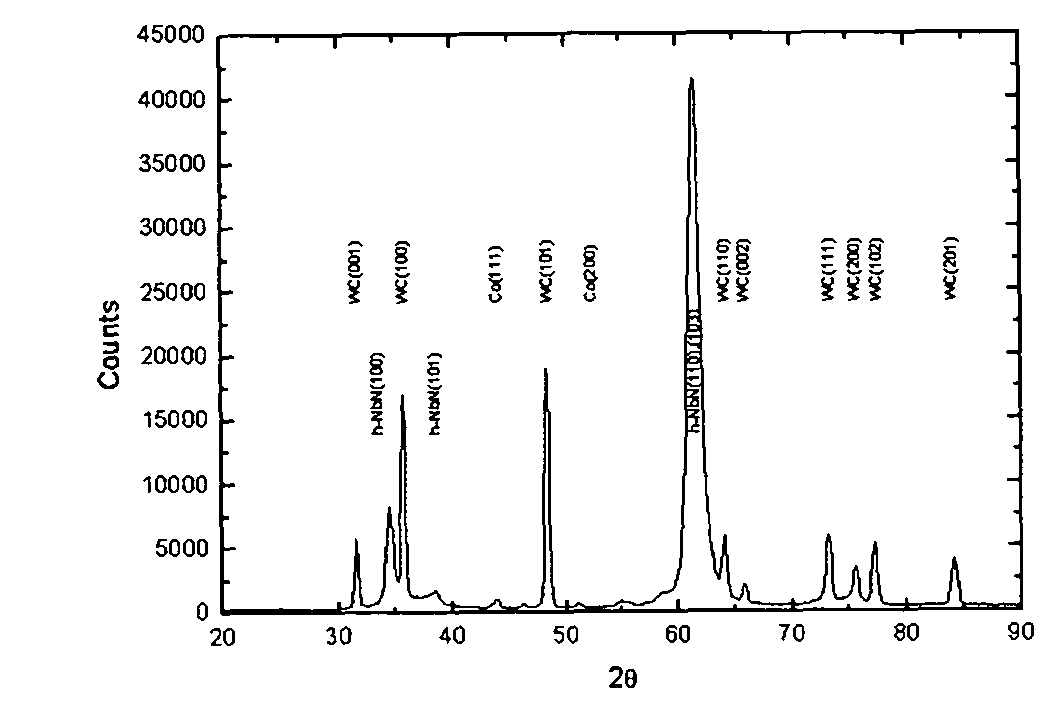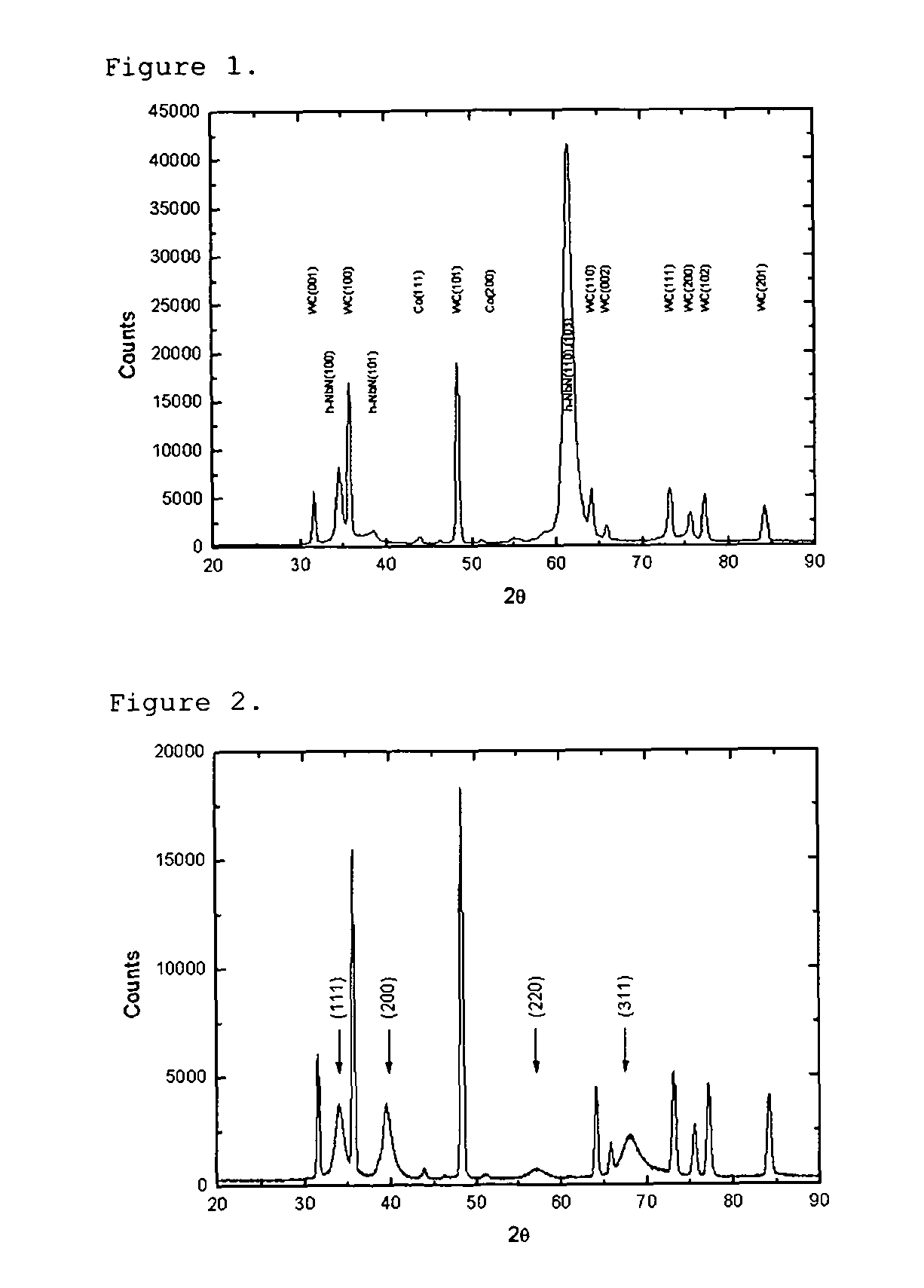Thin wear resistant coating
a technology of wear resistance and coating, applied in the direction of ion implantation coating, superimposed coating process, pigmenting treatment, etc., can solve the problems of accelerated wear of the layer and failure of the cohesion layer, and achieve the effect of improving the cutting performan
- Summary
- Abstract
- Description
- Claims
- Application Information
AI Technical Summary
Benefits of technology
Problems solved by technology
Method used
Image
Examples
example 1
[0050]Polished cemented carbide substrates with composition 93.5 wt-% WC-6 wt-% Co-0.5 wt-% (Ta,Nb)C were used. The WC grain size was about 1 μm and the hardness was 1630 HV10.
[0051]Before deposition, the substrates were cleaned in ultrasonic baths using alkali solution and alcohol and subsequently placed in the PVD-system using a fixture of one-fold rotation. The shortest cathode-to-substrate distance was 160 mm. The system was evacuated to a pressure of less than 2.0×10−3 Pa, after which the substrates were sputter cleaned with Ar ions. The layers were grown using arc evaporation of Nb and Zr cathodes (63 mm in diameter) mounted so a vertical metal composition gradient varied from Nb0.97Zr0.03 to Nb0.29Zr0.71 (measured by EDS). The nitrogen content (measured by EDS) of the variants containing h-AIN was between (Nb,Zr)N0.77-0.92. This means that the ratio R=(at-% X) / (at-% Me1+at-% Me2) is between 0.77 and 0.92 where X is N and Me1 is Nb and Me2 is Zr.
[0052]The deposition was carrie...
example 2
[0059]Cemented carbide exchangeable end mills of type MM12-12012-B90P-M05 with composition 90 wt-% WC-10 wt-% Co (WC grain size 0.8 μm) were coated using similar deposition conditions as in Example 1 (the name of the variants in Example 2 refers to variant names in Example 1 with similar composition). A fixture with three-fold rotation was used. The end mills were positioned at different levels in order to get different composition. The deposition period was adjusted from example 1 to 140 min in order to get 3.0 μm on the flank face. As a reference a TiN coated end mill of the same geometry and substrate was used, here called TiN. The layer thickness on the flank face on this variant was 1.4 μm.
[0060]A semi-finishing copy milling test was performed using the following cutting data:[0061]Material: DIN X100CrMoV 5 1, 59HRC[0062]n=4050 rpm[0063]ap=ae=0.9 mm[0064]vf=900 mm / min[0065]hm=0.015 mm[0066]After 30 min in cut the maximum flank wear, Vbmax, was measured at two different position...
example 3
[0069]A copy milling test using RDHW10T3M0T-MD06 inserts coated similarly as in Example 1 (variants A, C and E). The tool life was measured when the inserts were worn out as defined as when sparkles were created and the material got an uneven surface. Tool life is reported in table 3.
[0070]Material: DIN X155 CrMoV 12 1, hardened to 58 HRC
[0071]Dry machining
[0072]vc=250 m / min
[0073]fz=0,2 mm / tooth
[0074]ap=1 mm, ae 2 mm
[0075]
TABLE 3Tool lifeTool lifeVariantEdge 1 (min)Edge 2 (min)A5.24.5C4.35.4E2.52.8TiN3.12.5
[0076]In this test the variants with high amount of h-(Nb,Zr)N, as variant A (single phase h-NbN) and C, have the longest tool life.
PUM
| Property | Measurement | Unit |
|---|---|---|
| 2θ | aaaaa | aaaaa |
| 2θ | aaaaa | aaaaa |
| 2θ | aaaaa | aaaaa |
Abstract
Description
Claims
Application Information
 Login to View More
Login to View More - R&D
- Intellectual Property
- Life Sciences
- Materials
- Tech Scout
- Unparalleled Data Quality
- Higher Quality Content
- 60% Fewer Hallucinations
Browse by: Latest US Patents, China's latest patents, Technical Efficacy Thesaurus, Application Domain, Technology Topic, Popular Technical Reports.
© 2025 PatSnap. All rights reserved.Legal|Privacy policy|Modern Slavery Act Transparency Statement|Sitemap|About US| Contact US: help@patsnap.com



